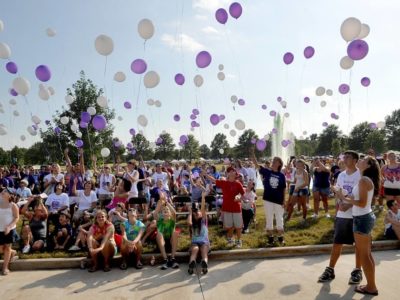With more than 500 chapters nationwide, Relay For Life is one of the most popular collegiate organizations there is. Participants commit yearlong to fundraising and planning the main event—a 12 to 24-hour run against cancer—for the American Cancer Society. All collegiate chapters have the same goal: to celebrate the survivors, remember the victims and fight for cancer victims. Each event consists of a survivors’ lap, a Luminaria ceremony — during which participants write names of victims on bags and light candles for them —a nd a Fight Back Ceremony, which allows participants to make commitments to Relay. Through researching the money raised and the number of participants, we’ve compiled a list of the most inspiring collegiate Relay For Life events:
1.) Virginia Tech
With almost $370,000 raised and 5,000 participants (and counting!), Relay is a community-wide event at VT, said VT Relay’s director Anna Tobia. In 2009, the event moved to the expansive Drillfield — at the center of campus — and drew in half a million dollars. VT was last year’s number one university for online fundraising and raised more than $600,000. “We’re always trying to outdo ourselves,” Tobia said. Last year’s Relay included an America’s Got Talent group, which brought in $23,000 in one night. “Everyone comes together for one cause and it has large student involvement, so it’s really special for everybody,” said assistant director Adam Ford.
VT will be live streaming its event this weekend from 5 p.m. to 5 a.m. Check out VT Relay’s 2010 video time lapse. It’s insane!
2.) University of Michigan, Ann Arbor
Strength in numbers holds true in Michigan. As the number four collegiate Relay last year, Michigan raised more than $345,000 for its 24-hour event. “We’re a huge institution so the event brings together so many corners of campus,” event director Sam Lewis said. “Everyone works really hard to build up the event. We’ve worked hard to get where we’re at.” Michigan raised almost $330,000 for this past weekend’s event because of Relay members’ dedication, Lewis said. “Two days after the main event, we’ll already start laying out the schedule for next year’s Relay,” Lewis said.
3.) University of Georgia
As the first collegiate Relay, UGA aims to raise more than $400,000 each year, said Chelsea Smith, marketing co-chair for UGA’s Relay. UGA has more than 2,500 participants and $215,000 raised so far for this weekend’s event. Smith said seeing UGA students who have fought, beaten or are suffering from cancer inspires people to join Relay. UGA’s Relay also has special significance because its cancer research facility has come close to developing a breast and pancreatic cancer vaccine.
4.) Washington University in St. Louis
Despite its size, Wash. U has become a top collegiate Relay, raising $276,000 last year. In its tenth year, Wash. U has reached its goal of $2 million in fundraising, said Miriam Dresner, fundraising development chair. Relay holds special meaning this year as students remember the vice chancellor of students, James McLeod, who died of cancer. Dresner said Wash. U’s Relay has grown so much because of student campaigns explaining “Why We Relay” and encouraging students to join the fight.
5.) Georgetown University
This roughly 7,600-undergrad school is only in its seventh year of Relaying, but has already raised more than $1.4 million. Georgetown’s Relay remains exciting each year with fundraising competitions against Syracuse (see #six), carrying over from its notorious Big East basketball rivalry. As the fifth highest-grossing collegiate relay last year, Georgetown raised more than $315,000. “We’re competing with giant schools, but we’re able to raise just as much money,” said event chair Matt Archambault. “Per capita, we’re an incredibly strong event.” He added that joining groups like Relay gives students a sense of community at a school with no formal Greek life system.
6.) Syracuse University
Held in the Carrier Dome — a huge indoor athletic facility — tons of students flock to Syracuse’ Relay. “A lot of collegiate relays are outside or in gyms, but in our location it’s amazing to see the Luminaria bags high up in the stands,” event chair Katie Bresnahan said. Last year’s event raised $175,000 and had more than 2,500 participants. “People from all different groups come together to show support,” Bresnahan said. She said that alumni and student survivor presence makes Relay a focal event at Syracuse. “Everybody has been touched by cancer in some way or another, and people want to share their stories at Relay.”
Photo: at http://www.ithaca.edu/orgs/cac/relayforlife/aboutrelay/



















